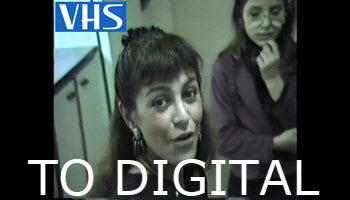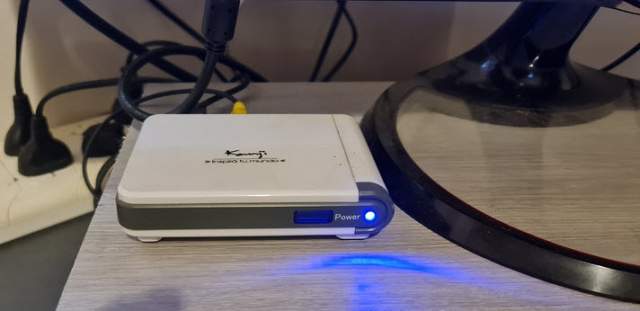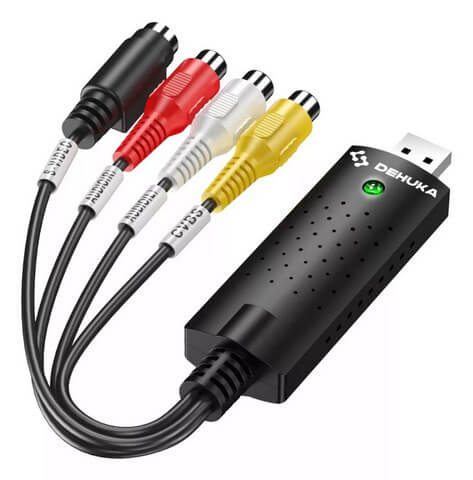Back in August 2019, I wrote about my experiences in transferring VHS tapes to digital format in Golden Videos VHS To DVD Converter Review and How To Transfer VHS Tapes To Digital Media. Since then, I’ve converted hundreds of VHS videos for my customers, but it hasn’t been plain sailing all the way. Since that time, the crappy Easy Cap USB adaptor failed (as did a replacement) and I’ve been using a Kanji USB box ever since, which so far hasn’t let me down. What I have learned is that having backup devices is essential, none more so than backup VCRs which are prone to failure due to their very nature – they are mechanical devices that wear out over time.
Video Cassette Recorders – VCRs
I have a love-hate relationship with these mechanical beasts. When they work, they are true marvels of engineering, but when they don’t, they are very difficult to repair because spare parts are either very expensive or impossible to source. As of today’s date, I have five VCRs in the lab – two JVC, two Samsung, and one Sony machine, with only the last two in working order, of a sort.
Several years ago I bought the Sony VCR from a friend for no more than a couple of bucks because she was moving house and simply wanted to get rid of it. It’s a very high-quality SLV L56 model with an excellent remote control, however after a few weeks of use, it wouldn’t eject the tapes and froze up with an unknown error on the tiny LED message screen. Long story short, I laid it up for a few years, having acquired a JVC which then began to chew up the tapes. So I dusted off the Sony and after many hours of frustration discovered that the ‘door’ or ‘mouth’ into which the tape slides (and obviously comes out of) being made of plastic, had become bowed, presumably through heat, thus preventing the tape from ejecting. This confused the machine in a HAL 9000 fashion, thinking that the user (me) wanted to replay the tape again. In the end, I removed the lid and the front panel (which houses the mouth) and have been able to play tapes normally, much to my delight. Once I’ve finished the latest batch of 40 VHS-C tapes to copy, I’ll take a hair dryer to the plastic panel in an effort to un-bow the offending mouth and put the machine back together again. Frankly, there’s nothing more frustrating than not knowing the cause of a problem, but finding it is definitely a Eureka moment.
As for the others, some will play VHS-C, others will, with snowy results, and others chew up tapes, so those are future repairs, but at least I have two in working order.
USB Video Adaptors
I’ve used PCI video capture cards in the past, but all the older models are no longer supported by Windows 10/11 and the newer cards are ridiculously expensive, so USB devices are the only option. Many swear by Easy Cap, but my experience has been crap, to say the very least. They are just cheap and nasty, probably designed to fail after a month or so.
As mentioned earlier, the Kanji device that I picked up purely by chance has been a Godsend. It has worked flawlessly with the Golden Video software and is always recognised by Windows 11. However, it clearly takes time to copy VHS tapes because of the length of each tape, so I’m setting up another PC so that I can run two VCRs at the same time, thus cutting down the delivery time, not to mention being paid faster!
Today I should receive a Dehuka USB adaptor, hoping that it’s better quality than Easy Crap, so I’ll report back with my findings when the Internet returns!
- VHS To Digital – The Highs And The Lows – Part One ⬅ You are here
- VHS To Digital – The Highs And The Lows – Part Two
- VHS To Digital – The Highs And The Lows – Part Three
—





Nice read mate. I transferred all my VHS tapes to digital years ago using a Leadtek adapter which includes WinFast VC100 U Video Editor software. It did a fantastic job but, unfortunately, it appears to have been discontinued: https://www.pccasegear.com/products/14637/winfast-vc100-u-video-editor
VCRs were arguably the most susceptible to breakdowns of any device ever produced… all those little cogs, wheels, levers, and belts. Not sure if they were a mechanical marvel or a mechanical nightmare. I tend toward the latter. 🙂
They certainly test my patience, mate, that’s for sure!
I have 240 VHS and S-VHS tapes, as well as 45 Hi-8 tapes, consisting of once-in-a-lifetime recordings, which I have been encoding using my trusted Dazzle DVD Recorder HD device. It has been working like a charm, especially using the S-VHS outputs. Agreed that it is going to be a long, drawn out project as I have to encode everything in real time. However, I have two Panasonic recorders – one VHS and the other S-VHS in practically new shape. So, I guess I am set for some time.
That will keep you busy for some time to come, Harry.
Enjoy the challenge!
Hi Harry, Larry here. I have 4 Hi-8 tapes that were recorded in 2003 on a, then new, Sony 340 camcorder. I’m not at all familiar with converting to digital. I still have the camcorder and surprisingly it is still in good working order, so I can view the tapes on the camcorder screen. The camcorder has a USB and an S-Video output. Do you think the Dazzle DVD Recorder HD device would work for me? Thank you in advance for any help you can provide.
Hi Larry,
Happy to help. You mentioned S-VHS and USB outputs. Does it also have RCA outputs for audio? I am sure it does.
Harry